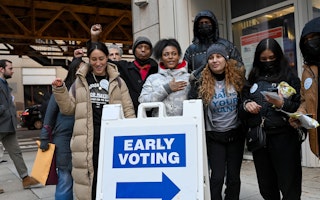Texas Redistricting—A Gift that Keeps On Giving
By Anita S. Earls
A long-time priority for the Open Society Foundations is expanding nonpartisan community-based involvement in the U.S. democracy. The Southern Coalition for Social Justice, a Durham, North Carolina based organization and grantee, played an important role in a recent redistricting victory. The Southern Coalition's executive director, Anita Earls, provides this summary of her organization's work on a successful legal challenge to Texas's proposed redistricting plan.
Of the 16 states covered by the preclearance requirements in Section 5 of the Voting Rights Act, which requires states with a history of discriminatory voting practices obtain advance approval from the federal government before changing their election laws, few have treated the Act’s protections with such disdain as Texas.
Indeed, since January 2009 Texas has received more Section 5 objections under the Act than any other state. And once again, the state of Texas has been rebuked in a court of law for its treatment of minority voters in the redistricting process. The gift is that the racial discrimination in the Texas redistricting maps has led to federal judges issuing strong opinions finding intentional discrimination that serve as important precedents for litigation around the country.
A little over a week ago, a panel of judges in D.C. rejected all three of Texas’ statewide redistricting maps (Congressional, State House, and State Senate) as violating Section 5 of the Voting Rights Act. The Southern Coalition for Social Justice represented the Texas NAACP in the litigation. Several other advocacy groups were involved in highlighting for the D.C. Court the negative impact that Texas’ enacted plans would have on minority voters. African American, Latino, and Asian voters’ interests were at stake.
Of particular interest and importance, in addition to finding that the enacted Congressional plan would make minority voters worse off with respect to their ability to elect the candidates of their choice, the court went on to find that the Congressional plan was also intentionally discriminatory. The court heard testimony about how the districts of minority representatives were unnecessarily “sliced and diced,” with important economic engines removed. The court found that the districts of no Anglo Congresspersons had been treated in such a manner—the laughable “coincidence” explanation offered by the state was soundly rejected. And the court likewise recognized the discriminatory intent motivating the state Senate plan. Even the Department of Justice refused to take a firm stand on how Texas’ discriminatory intent manifested itself in a manner harmful to minority voters. But voting rights advocates and many impacted voters of color from the state once again stood strong against Texas’ unrelenting attempts, through redistricting, to deprive voters of color the ability to participate equally in the political process. And those voters and advocates scored a huge victory.
In a year in which numerous challenges to the constitutionality of Section 5 of the Voting Rights Act are potentially headed up to the Supreme Court, the most significant consequence of the Texas redistricting decision has yet to be seen. With conservative pundits and judges questioning the continuing need for Section 5—which was initially designed to impede devious and intentionally discriminatory maneuvers to suppress minority voter participation—a broad finding that the state of Texas, a covered jurisdiction, has engaged in barely veiled acts of invidious discrimination on the basis of race, offers a resounding rebuttal to those claims that protections of the Voting Rights Act are no longer needed.
Similarly, litigation over state legislative or congressional redistricting plans is still pending in 25 states. This decision will be a useful precedent in any state where equal protection claims have been brought, whether or not the state is covered by Section 5 of the Voting Rights Act.
More broadly, civil rights advocates for years have bemoaned the fact that it can be difficult to prove intentional racial discrimination. This opinion, based on common sense conclusions drawn from irrefutable evidence of the impact of the state’s proposed new district lines, shows that fair-minded judges can be convinced that state actors have engaged in intentional racial discrimination. For that they need committed community activists who document how they are impacted by unfair districts, and experienced litigators who can effectively present that evidence to a court. The opinion in this case is a roadmap for how to use the judicial system to achieve racial justice. It’s a gift we should make good use of.
Anita S. Earls is executive director of the Southern Coalition for Social Justice.


